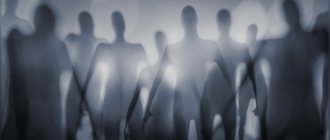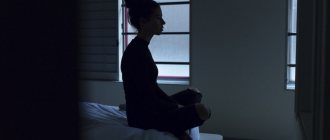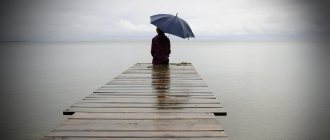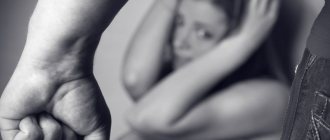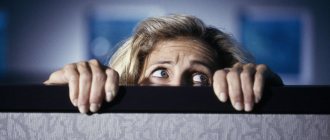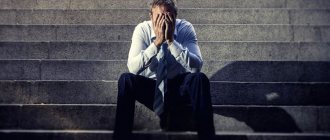I'm afraid to be alone, I can't be alone!, I feel bad/scared alone!, It's harmful for a woman to be alone!... Are you familiar with such thoughts? Fear of loneliness, especially among women, is a very common phenomenon and one of the main women's problems. Where does the fear of loneliness come from, how to get rid of the fear of loneliness, and in general, is it possible not to suffer alone?
Being alone is terrible, it sounds like a curse! - Yes, that’s often how it seems and is thought. But it is not at all a fact that behind this “horror” there is something real and worthy of tragedy.
Why did the child suddenly become afraid of being alone?
Childhood phobias are common. The prerequisite is an unformed psyche. That is why children's fears are not a pathology. This is an age-related feature that must be taken into account and controlled. What to do if a child is afraid to be alone at home or in a room? We will examine the answer to this question in more detail in this article.
Let's look at the main reasons for fear:
- Scary stories, fairy tales, animated films, the characters of which often frighten children and adults. For example, when persuading a child to eat another portion of porridge, parents scare him with Baba Yaga or Kashchei the Immortal.
- Children with a high threshold of empathy and sensitivity, experiencing a special attachment to their parents, may be afraid of being left without them.
- A phobia can act as a consequence of stress suffered at school, in the yard or kindergarten.
- An obsessive fear of death or darkness is often formed under the acute impression of a terrible episode seen on TV or an emergency situation experienced in real life.
- Scary dreams become a common cause of persistent fear.
- Pathology of the central nervous system.
- Physical and psychological violence, trauma suffered by children.
Fear is the body's natural protective reaction to danger. To preserve the child’s mental health, parents need to reduce the amount of television they watch and limit the time spent on the Internet.
Main signs of street fear
The fear of going outside is reflected by the following signs:
- Anxiety. As the disease progresses, fears take on new colors; the client is even afraid of what is happening in his thoughts. He invents many scenarios and plots of events for himself, driving himself deeper into his own cage of hopelessness.
- Cardiopalmus. A panic attack feels like a claustrophobic attack. The client panics, loses his bearings, sweats, his heart rate increases, and it becomes difficult to breathe. This condition occurs when the home is abandoned and there is unprotected space around.
- Difficulty breathing. Characteristic of panic attacks. Violation of the correct rhythm leads to panic of a hypochondriacal nature. The person is afraid of suffocating and loses control.
- Weakness of muscle structures. Occurs during prolonged emotional stress. Apathy begins, the person loses strength, he ceases to be interested in what is happening around him.
- Nausea. This symptom clearly shows disgust, rejection of life. Tablets are powerless. The condition normalizes on its own after treatment of the underlying cause.
- Obsession. The slightest problem becomes an insoluble tragedy. The client considers himself a failure, a leper.
- Feeling hot. At the moment of panic, the face turns purple, a surge of warmth is felt, blood pressure and pulse rise. Against this background, noise is heard, ringing in the ears, sweat appears.
- Pre-fainting state. Severe dizziness can cause fainting.
- Cramps. When there is strong fear and panic, a person begins to shake when going outside, and short-term convulsions occur.
- Losing your bearings. The client does not remember where he came from, does not understand which direction to move in order to find protection.
- Stomach upset. It may manifest as diarrhea or, conversely, constipation. It occurs due to stress.
The fear of going out is psychologically manifested by the fear of having an attack in public, losing your mind, losing control, depression, constant obsessive anxiety, and low self-esteem.
Age-related characteristics of fear in children who are left alone in a room or at home
Every child experiences the fear of being alone. Let's look at each of them in detail.
Children at 5 years old
At the age of 5, a child is already thinking about death. The kid, being left alone, understands that at any moment his loved ones can leave this world forever. Most phobias inherent in children at this age are based on the fear of death. A natural part of growing up is the fear of being alone in a room or house. After all, at this time, irreversible things can happen to parents.
Often, psychodiagnostics do not reveal any pathologies. Experts in the field of developmental psychology recommend that mothers and fathers spend as much time as possible with their children and pay attention to intimate conversations.
Children aged 6
The fear of death can, over time, transform into a fear of natural disasters, disasters, and war. At 6 years old, children are especially susceptible to global upheavals broadcast 24/7 by the media. The stress experienced from seeing a scary episode on TV can cause fear when the baby is left alone in the room.
Impressed by what he saw, the baby draws dramatic pictures in his imagination that scare him even more. Children at the age of six are very open and literally absorb all information coming from outside. For example, after learning about the dangers of certain foods, the baby refuses to eat and go to the toilet. Parents should control and strictly suppress sources of negativity that can hurt a fragile psyche, and try not to leave their children alone in the room where the TV is on.
Children at 7 years old
At 7 years old, a child often wonders about his future. He is concerned about his own appearance, how he looks in the eyes of his peers. At this age, with going to school, he enters a new period of life. Stress is often associated with a new environment, daily schedule, increased physical and psycho-emotional stress.
For example, many first-graders are afraid of being late for class and face difficult relationships in a new team, ridicule from classmates, and isolation. Unsolvable inner anxiety transforms into an obsessive fear of being left alone at home.
At seven years old, a child is puzzled by the present and afraid of the future. It is important to establish a positive home environment. Observing happy, calm, satisfied parents, the baby finds a resolution to the internal conflict and gradually calms down.
Child 8 years old
In the process of growing up, old fears go away, giving way to new phobias. For example, at the age of eight, children are often worried about the positive reaction of adults to their behavior.
The period of elementary school is associated with anxiety about getting a low grade, reprimand from the teacher, and being on time for the lesson. A busy schedule and new obligations become a real test for the student’s psyche. Under the influence of psycho-emotional stress, a fear of being left alone at home or in an apartment often develops.
Children aged 10
Personality transformation that occurs during adolescence is often a prerequisite for the formation of anxiety. Already at the age of ten, a boy or girl can wonder “who am I?” This is where the fear of not being yourself comes from.
Active hormonal changes in the body are accompanied by violent emotional reactions. “I’m strange, not like everyone else,” “there’s something wrong with me”—sometimes such statements become firmly part of everyday reality and significantly complicate the life of a ten-year-old child.
Treatment of agoraphobia with panic attacks
A feeling of fear in open places or on the street is a problem associated with a mental state disorder and cannot be controlled by the efforts of one’s own will; it requires the mandatory participation of a medical professional with higher medical education, a psychiatrist or psychotherapist.
Agoraphobia with panic attacks can be treated using complex techniques from a psychotherapist. Active neurometabolic therapy, psychotherapy are used, physiotherapeutic procedures are often prescribed, and a daily routine and diet are selected.
Treatment of agoraphobia with panic attacks is selected only individually, only after a thorough examination and identification of the true causes of the formation of a violation of the biological processes of the brain. It is not the symptoms that are felt by the person that are treated, but the cause that the person does not feel. The true reason is sometimes very well hidden from the eyes of non-specialists, and even more so from the person who suffers from it. Treatment of agoraphobia and panic attacks by psychologists or ordinary psychotherapists, without higher medical education and education in psychiatry, should be categorically excluded.
Prognosis for treatment of agoraphobia with panic attacks
Agoraphobia with panic attacks is treatable and the prognosis, as a rule, is favorable with proper treatment and following all the instructions of the attending physician.
If there is no treatment or incorrect treatment, the prognosis is usually not favorable.
Call
We can help you.
How can you find out the cause of fear?
So, at every age, a child can feel inner restlessness. Raising an initiative, courageous, and self-confident personality is integrally connected with overcoming fear and resolving internal conflict. An adequate reaction of parents to a child’s phobia of being left alone will allow it to be correctly and completely eliminated.
A confidential conversation comes to the rescue. It’s great if a mother or father, during a friendly conversation, unobtrusively gives examples from their own life. It is necessary to show empathy, which will convince the teenager that he is not alone in his mental turmoil and will gently relieve anxiety.
Parental authority should be expressed in respect, not fear. A favorable family atmosphere, a balanced and loving father and mother are the guideline that will lead a person through all life's obstacles.
Psychologists offer several effective, experience-tested ways to solve the problem.
We sculpt figures or draw
Psychologists recommend drawing your fear. Let the child boldly look his enemy in the eye, armed with paints and pencils. Invite him to feign fear, and then destroy the paper.
An effective method is modeling from plasticine. Spend a few minutes with your son or daughter playing an exciting game, the result of which will be a figure defeated in a fair fight, personifying the fear of being left alone.
Through games
Modeling of problem situations is often used in psychodiagnostics. Play a game with your daughter or son, switching roles. Add variety to the process with toys. Create a staged performance as a result of which you will not only get answers to the question of what exactly worries the baby, but you will also be able to eliminate the problem.
Treatment of agoraphobia
When there is a fear of leaving the house, each case requires an individual approach, drawing up a treatment regimen. Apply:
- Drug treatment. Helps to temporarily stabilize the emotional state so that he can overcome the disease.
- Psychotherapy. It can be individual or group. Helps to stabilize the mental background, identify the problem, and learn to look at the current situation from the other side.
- Hypnosis. Used to identify the cause of the development of a phobia, if this cannot be done by other methods. Also, with the help of hypnosis, a specialist can give the necessary commands to correct the client’s behavior.
The optimal age when children stop being afraid when left alone at home
Children's fears and phobias are individual in nature. Some children can safely stay at home even at four years old. Experts say that the optimal age when a child can calmly tolerate loneliness begins at seven to eight years old.
The concerns associated with one elementary school student being at home should receive close attention. As a rule, fears pass over time, but in especially susceptible children, they can develop, developing into neurosis.
Manifestations of agoraphobia - fear of open places, fear of going outside
The main, leading symptom of agoraphobia is the fear of open spaces, the fear of going outside, the fear of entering large rooms (halls, recreation rooms, long corridors, rooms with high ceilings, etc.). Agoraphobia can manifest itself in the form of a variety of symptoms, which can manifest itself in the form of: - uncontrollable, unclear fear; - in the form of suffocation, palpitations, a lump in the throat and other somatic phenomena; - weakness in the legs or throughout the body; - internal trembling; - increased sweating, feeling hot, feeling cold
However, most often agoraphobia is accompanied by several symptoms at the same time, which can be combined into one well-known term - panic attack. Therefore, doctors most often treat agoraphobia with panic attacks.
Phobias are obsessive fears. Phobic anxiety Feelings of fear in open places or on the street Fear of leaving the house alone Fear of riding in public transport Need to avoid certain places or activities Fear of fainting
What is forbidden to do if a child has already developed a phobia?
It is strictly forbidden to act in the opposite direction. When going to bed, it is recommended to leave his favorite toy with the baby. By deliberately leaving your child alone in the room, you aggravate the situation and develop in him a feeling of rejection and loneliness.
Under no circumstances compare your offspring with other children! Many parents are guilty of this, forming an inferiority complex in their beloved child.
It is important for all parents to be vigilant and pay special attention to children's fears. Experts recommend talking to your baby as often as possible, establishing friendly and trusting relationships with him. This will allow you to identify the problem in a timely manner and correct your behavior.
Treatment of pathology
Before prescribing treatment, the patient must visit specialized specialists (general practitioner, cardiologist, psychiatrist, neurologist), who will rule out diseases with similar symptoms.
To get a complete picture of the disease, psychiatrists usually use a number of tests: anxiety scales and panic attack assessments, Beck Depression Test.
Drug treatment consists of selecting antidepressants, tranquilizers and antipsychotics that correspond to the severity of the disease. Along with medications, psychotherapeutic sessions are conducted with the patient (Ericksonian hypnosis, cognitive behavioral therapy, Gestalt therapy, etc.).
In addition, the patient is recommended to use relaxing techniques at home (breathing techniques, muscle relaxation exercises, meditative practices, art therapy, etc.), which can be studied in specialized literature or via the Internet, for example, in a video blog
Development mechanism
As a rule, it all begins with a panic attack that appears in a characteristic situation, and therefore the connection “leaving the house – danger” is formed in the subconscious. As a result, fearing that panic attacks will overtake him again on the street, a person tries to eliminate risk situations from life: limiting himself in movement and communication.
At moments when the patient is forced to leave a comfortable environment, he involuntarily exhibits somatic signs of anxiety:
- cold sweat;
- increased heart rate;
- severe nausea;
- dry mouth;
- lack of air;
- pain in the heart area;
- weakness and trembling in the limbs;
- general pre-fainting state.
Falling into panic, a person asks those nearby to take him to a place where he could feel out of danger. In crowded places (transport, cafes), the agoraphobe tries to stay as close to the exit as possible or at least keep the doors in sight. Often, a person suffering from agoraphobia creates for himself certain routes that are the safest in his opinion.
The clinical picture may contain anticipatory anxiety, avoidant behavior, and depressive symptoms.

